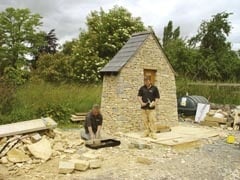Walling : A house of straw and stone
Martin Fildes of Riverdale Stone built a straw bale and dry stone walled cottage for himself and his family to live in while he built his house (using traditional build with mortar). At Hampton Court Flower Show this month (July) he received the DSWA Pinnacle Award for the cottage. Now Martin believes dry stone walling could be the solution to affordable housing
The stone walled offices of Riverdale Stone in Sharnbrook, Bedfordshire, look anything but temporary. But you could remove them and hardly know they had ever been there.
Martin Fildes, the owner of Riverdale Stone, constructed the building for himself and his family to live in while he was building their house in the same Weston Underwood limestone that the outer walls of the offices are made of – he particularly likes the variation in colour of the stone – although for his own home he has used traditional mortar construction while the offices have dry stone walls.
And the dry stone walls have been laid to such a high standard that Riverdale Stone have been given the Dry Stone Walling Association’s highest accolade, the Pinnacle Award, for them. The Award was presented this month at the Royal Horticultural Society’s Hampton Court Flower Show, where Riverdale Stone were launching the dry stone walled garden room and home office pictured on page 30.
Behind the dry stone walls of Riverdale Stone’s offices, isolated by a layer of Tyvek, are bales of straw sitting on a suspended wooden floor to keep them dry, which is important or they would rot. The timber frame is supported on Swift concrete bases sitting on hardcore. There are no other foundations.
The straw bales make the walls a metre thick. Inside, chicken mesh was put over the straw to act as a lathe to hold the 25mm lime plaster on to the walls, making them look as if they had been constructed of solid stone.
Lime plaster was used in order to accommodate any movement, although Martin told NSS: “I’m gobsmacked how little movement there has been. Houses built traditionally to modern building regulations settle and shrink, but there’s no signs of any cracks in the plaster here three years after we built it.”
He admits there were problems building with straw bales. The most difficult was keeping them dry during construction. He says in hindsight he should have put the roof on first and the straw in last.
And although straw is exceptionally ‘green’ and an excellent insulator, Martin says: “This was the first house I’ve built using straw bales and will probably be the last, if I’m honest.”
But he enjoyed doing it. He learnt dry stone walling from Geraint Davies, who he works with, and says: “Both of us are from a construction background and there is a part of us that is always hankering towards the old ideals. Old buildings lasted forever. We thought: how can we take it to the extreme? So we used dry stone walling and straw.”
As a result of building his cottage, Martin came up with the idea of using the construction method to construct garden rooms and home offices as a more attractive alternative to wooden sheds, although he has substituted the straw bales for easier Sips panels. As he says, dry stone walling will just become increasingly attractive with age.
And it was these rooms that he launched at Hampton Court Flower Show this month by exhibiting the one pictured at the top of this page when it was in his yard in Sharnbrook, where it was constructed initially before being dismantled and reconstructed at Hampton Court. Martin says it only took him and Geraint a day to put it up again because all the stone had already been dressed.
In front of the structure at Hampton Court were sections of paving prepared in plastic trays for ease of installation and small boundary walls. The idea was to show some of the variety of stones that could be used to match the traditional building stones in any part of the country. “It will make people aware that dry stone walls are not just for field boundaries,” says Martin.
And all the stones on the Riverdale Stone stand were British. “The tide has turned a little bit,” says Martin. “People want to use local stones. We do have some wonderful stones in this country and people are questioning the ethics and environmental impact of imports.”
Martin now thinks the system could also be used as a quick and low environmental impact way of producing affordable housing, especially in rural areas where there is a particular shortage of low-price housing and it is much more difficult to get planning permission.
Because there are no concrete foundations or mortar in the walls, the whole structure could easily be removed if the demand for the housing disappeared.
The dry stone walling, in spite of being easily dismantled, would give a permanence to what in effect would be a temporary structure. And Martin refutes the suggestion that dry stone walling would be expensive.
He accepts that it takes longer to lay a good stone wall than a brick wall, but says the house would be weatherproofed within a week by the Sips panels and the interiors could progress at the same time as the walls went up.
And, he says, rubble walling is not expensive in terms of stone because there is so little waste. He believes the overall cost of the system would be advantageous against traditional brick build with vastly improved aesthetics. “Overall, stone pays for itself,” he says.
Whether that idea pays off or not remains to be seen. In the meantime, Martin and Geraint are keeping busy building traditional stone houses in indigenous stones for their clients and neighbours.

